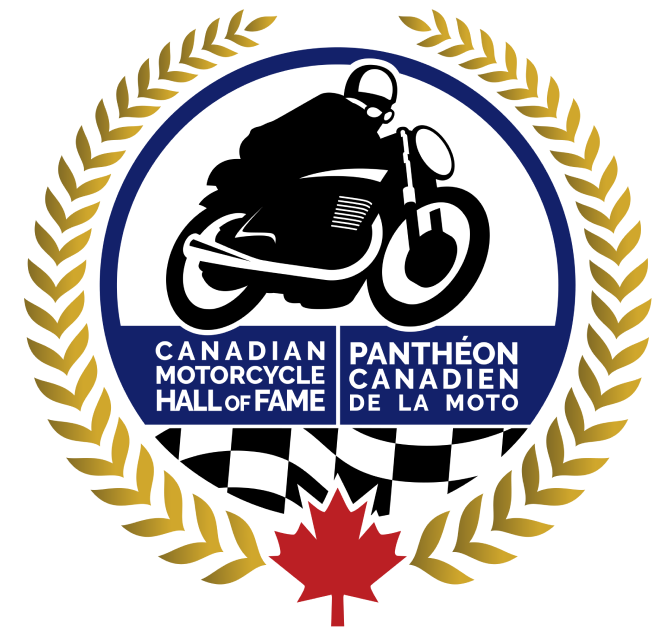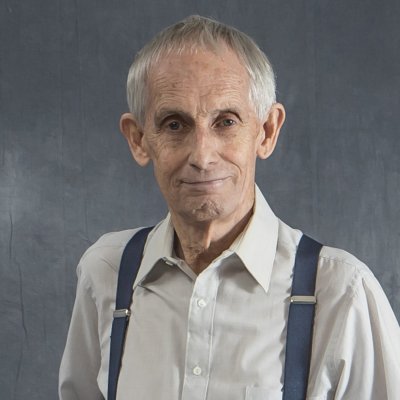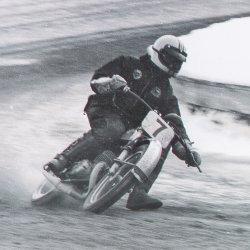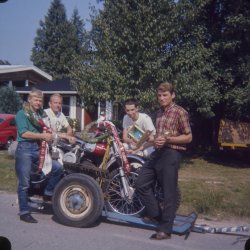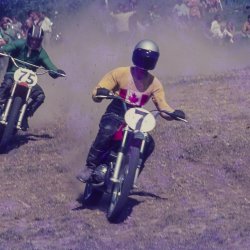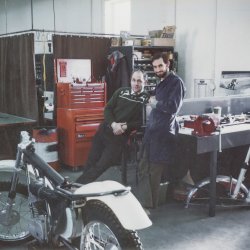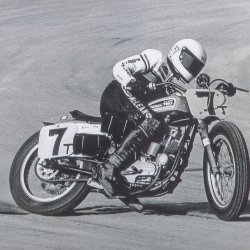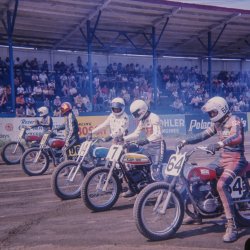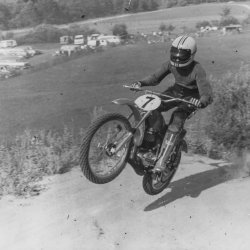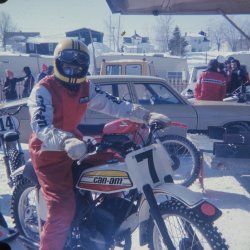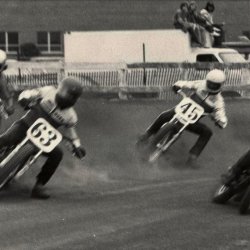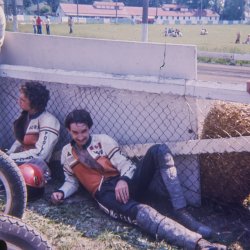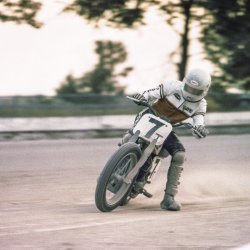David McLean - Class of 2023
As a child, David was curious about how things worked and had to take them apart. When he got older, the items got bigger and more complex. Satisfaction reigned when it all went back together, worked and no pieces were left over.
His early interest was cars and racing followed. Intrigued by a Formula 3 car with a Norton Manx engine, his focus turned to motorcycles.
He purchased a 200cc Triumph Cub, Joined the Nortown Motorcycle Club and went racing, resulting in the 200cc Junior Scrambles Championship.
In 1967, after spending 1½ years in California, he went to work as a mechanic for Sonic Motorcycles. A competition-oriented dealership started by Bill Sharpless and John DeGruchy, one could choose whatever Bultaco you wanted to ride and he decided to give ½ mile dirt track and spiked ice racing a try. This resulted in the 1969 Senior 250cc dirt track championship, the 1970 junior 250cc spiked ice racing championship and the 1971 Expert 250 spiked ice racing Championship.
In 1971, he received a call from Bob Fisher explaining that Bombardier wanted to diversify and include motorcycles and would he like to be a hands-on person in Research and Development.
After wins in all 250 classes on the ice, David moved to Valcourt and began work at Bombardier on Italian Agrati-Garelli motorcycles; a contract that had to be completed. Once summer came, Dave had to race again and won the Flattrack 250cc Expert Championship.
At summer’s end, a 125cc concept engine arrived from Rotax in Austria (a Bombardier company) and work began to build a chassis around it. An adjustable frame jig was made and a Gary Robison designed, concept frame and swinging arm were built around the engine with Ken Watkins doing all the welding. Suspension units and complete wheels were purchased in advance. Ron Ponech had designed and built a fibreglass tank and seat. By November it was complete and ready for testing. This was an astronomical job to create a motorcycle in such a short period of time!
By December, 125 and 175cc sandcast prototype engines arrived from Rotax and it was their responsibility to finalize the design of a production-oriented frame, swing arm, exhaust, etc. David’s responsibility was the care of six prototype engines, rebuilding each a number of times with improved parts and writing an evaluation report.
Jeff Smith arrived from England with two prototypes for testing in Las Vegas, he brought with him a 500cc BSA motocrosser that had won two World championships and R&D purchased the bike. David received permission from Gary to ride the BSA and modify into a dirt tracker. First lap he was shocked at the acceleration out of the corners; this was his intro to a 4 cycle, single cylinder engine’s ability to connect to the surface of the track. In 1972 he would compete in both the 250cc and 750cc ½ mile Expert dirt tracks and win the National Championship Title.
The best dirt trackers of this era were Dave and Doug Sehl and McLean joined them for 1973. They raced XR 750’s and McLean finished in the front half at the mile in Indianapolis. In the 1974 season at Syracuse Mile track, Dave Sehl set the fastest one lap time trial and McLean was second.
Back at can-am, the 250 MX-1 was ready for production. David was allowed to race one in the 360cc Class for 1975 and took the win at Belleville.
1975 was a disappointment for Bombardier. Even with the ISDT medals and winning the American Motorcycle Association professional 250cc motocross championship, sales did not follow. With the impending exhaust pollution regulations, all further development of on road motorcycles ceased and in 1976, Davis was unemployed. He was given the 1976 dirt tracker and a new 1972 50cc Agrati-Garelli minibike.
David raced the can-am for the next couple of years, the last one at Barrie in 1980 and it was retired.
In 1986, He moved to Whitby, near the Oshawa Competition Motorcycle Club which promoted ice racing at Port Perry. He purchased studded tires and went racing. Being away for 10 years, he was not up to speed with the Experts but the Veteran Class was where He belonged and was fortunate to win many races over 3 years.
David married Carol in 1989 and by the time he finished the 1991 ice racing, they were expecting their first child. Although he had never had an injury or missed work in 30 years, he realized with a family and a mortgage, it was time to retire.
In 2007, David met Paul Hollingsworth who had a 1976 175 can-am in poor condition. He asked if David could repair it and consequently, entered the world of “vintage” can-ams. Never interested in vintage bikes, David realized the can-am was 32 years old and people might like to hear it run so he became a regular at the CVMG Paris Vintage Rally.
He was asked to repair a 1978 can-am Qualifier by Rick Guilmette who was a collector and they started attending vintage off-road events using the Trail Boss for Motocross and then Paul’s Bultaco. Like before, he realized he didn’t have the strength and certainly not in his 70’s so he retired again.
For years, recording the history of can-ams produced from 1973 to 1986 had been discussed and in 2022, David volunteered to write the early history from 1971 to 1976 which was an important time in his life and much of the information was burned in his memory.
Motorcycling has been part of David’s life for 65 years.
